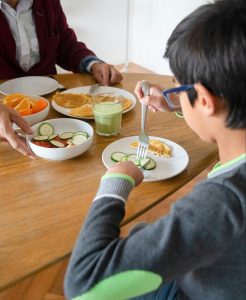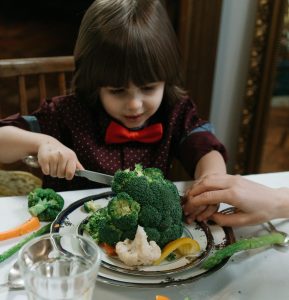6.2 Tomaten auf den Augen haben

Guten Tag!
Zum Aufwärmen machen wir unseren Tagesminiplausch und eine Wiederholung.
Wiederholung
In the previous lesson, you learned to say names of fruits that you eat and don’t eat. Let’s review what you have learned.
Play a quick memory game with yourself. In your written journal, jot down as many fruits as you can remember from the previous lesson. Then record your list in your audio journal. If you are unsure, go back and re-listen to the pronunciations.
Lektionsüberblick
To be oblivious to something in German is to have Tomaten auf den Augen (tomatoes on your eyes). To help you from having Tomaten auf den Augen as we learn about vegetables, this lesson will introduce you to a large variety of Gemüse typically consumed in the US. In the end, you will be able to 1) name at least 5 vegetables, 2) say which kinds of vegetables you prefer to eat, and 3) say which kinds of vegetable preparation you prefer.
Was weißt du schon?
Let’s do a quick skills check before beginning.
| Noch nicht start klar?
Du kannst immer auf die gleiche 1010-Lektion zurückgreifen! |
Not confident about starting this lesson?
You can always review the same Lektion from 1010. |
1) Gemüse kennen
Like you saw in the previous lesson about fruit, there are many vegetables names that are similar to English. How many do you already know? Click on the plus sign in the images below to read the names of vegetables you do not know and review the ones you do. Be sure to click through to each page (5 total pages).
Let’s practice
Kleiner Hinweis
Like in English, not every word in German has a plural. Take for example der Brokkoli or der Kohl. On a shopping list, a German speaker would typically write down a weighted amount, e.g. 500g Brokkoli, and that may be one or more stalks of broccoli. If you want to specify the stalks or heads of cabbage, you can form the plural through those words, e.g. 2 Kohlköpfe (if you just see Kohl that usually means Weißkohl), Brokkolistangen or Brokkoliköpfe.
Even for vegetables that can be counted, that same person would likely note the grams of the produce needed, since that is what will be on the ingredient list in a recipe.
Jetzt bist du dran!
2) Lieber und am liebsten
Welches Gemüse isst du lieber? Welches Gemüse isst du am liebsten? What vegetables do you prefer to eat? What vegetables do you like to eat the most? Look at the images. Read each person’s response.
 |
 |
 |
| Ich esse Gurken am liebsten. | Ich esse lieber Brokkoli als Blumenkohl. | Ich esse lieber Gurken als Spargel. |
Let’s practice.
Jetzt bist du dran!
Hamburg im Blickpunkt
 Das Hamburgische Wattenmeer ist ein Teil des Wattenmeeres der Nordsee und Nationalpark. Als Exklave der Freien und Hansestadt Hamburg liegt es nordwestlich vor Cuxhaven im Mündungsgebiet der Elbe zur Nordsee. Der Nationalpark ist zugleich Biosphärenreservat und von der UNESCO mit den anderen deutschen Wattenmeerparks, dem niederländischen und dem dänischen Wattenmeer als Weltnaturerbe anerkannt. Er umfasst neben den eigentlichen Wattgebieten auch die Insel Neuwerk und die Düneninseln Scharhörn und Nigehörn. Das Hamburgische Wattenmeer besteht überwiegend aus Sand- und Mischwatten mit flachen Prielen und Sandplaten.
Das Hamburgische Wattenmeer ist ein Teil des Wattenmeeres der Nordsee und Nationalpark. Als Exklave der Freien und Hansestadt Hamburg liegt es nordwestlich vor Cuxhaven im Mündungsgebiet der Elbe zur Nordsee. Der Nationalpark ist zugleich Biosphärenreservat und von der UNESCO mit den anderen deutschen Wattenmeerparks, dem niederländischen und dem dänischen Wattenmeer als Weltnaturerbe anerkannt. Er umfasst neben den eigentlichen Wattgebieten auch die Insel Neuwerk und die Düneninseln Scharhörn und Nigehörn. Das Hamburgische Wattenmeer besteht überwiegend aus Sand- und Mischwatten mit flachen Prielen und Sandplaten.

The Hamburg Wadden Sea National Park is part of the German Wadden Sea National Parks. It is an exclave of the city state of Hamburg and lies northwest from Cuxhaven in the estuary of the Elbe in the North Sea. The National Park is a biosphere reserve and, as part of the single ecological entity of the Wadden Sea reaching from Den Helder (NL) to Esbjerg (DK) have been recognized as a UNESCO World Heritage Site. In addition to the wadden sea areas, it includes the islands of Neuwerk, Scharhörn and Nigehörn. It is made up mainly of sand and mixed mudflats with shallow creeks, sand bars (Plaaten), and dune islands.
3) Gemüsezubereitung
Let’s talk about food preparation for this next section. Although many people enjoy raw vegetables (roh), many people prefer their veggies prepared in some fashion. Consider these ways:
Let’s review showing preference. Read the sample sentences below.
Ich esse lieber rohe als gekochte Karotten.
Ich esse lieber gekochten als rohen Brokkoli.
Ich esse lieber gesalzene als ungesalzene Tomaten.
Ich esse lieber Salat mit Sauce als ohne Sauce.
Let’s practice.
Kleiner Hinweis
A veggie tray is called die Rohkost. Do you remember what the word roh means?
Jetzt bist du dran!
Zum Schluß

*As you conclude this lesson, don’t forget to check Canvas!*
Here is a collection of idiomatic expressions featuring vegetables with German explanations.

Media Attributions
- Vegetable hotspot activity adapted from adapted from Grenzenlos Deutsch, licensed under a CC BY-NC-SA 4.0 International License
Media Attributions
- 1020-banner-large-reduced

